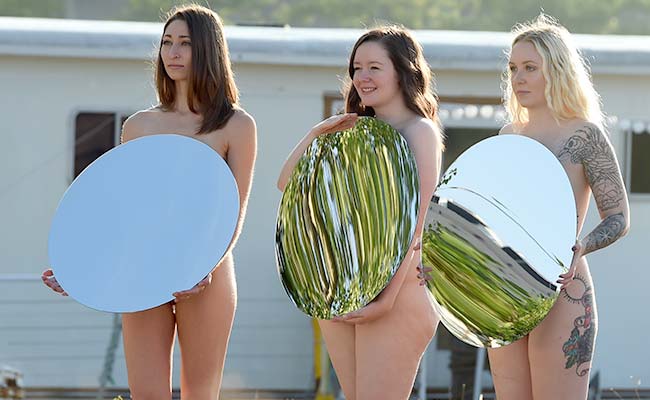The Artist Who Gathered 100 Naked Women Outside The Republican National Convention

Spencer Tunick is an American photographer best known for organizing large-scale nude shoots.
He had waited three years for this moment.
He wiped sweat from his brow and, 40 minutes after the sun's first rays cracked through the night, he gave the order.
"The Republican Party has given an excuse to hate. We have daughters and we want them to grow up in a society where they have equal rights for women," he told them, Esquire reported. "The sun is coming up. Now, when I say three, let's get naked."
One. Two. Three.
Zippers, buttons and clasps all came undone as the women's clothes hit the grass.
Bodies exposed and grins on their lips, they stood facing the Quicken Loans Arena, known to locals as "the Q." Then, they lifted large, round Mylar mirrors and held them up to the sun. Brilliant streaks of light bounced off the glass, rushing toward the arena.
The shutter on Tunick's camera began snapping as he captured the moment.
To many, it might be a strange - and perhaps uncomfortable - scene. For Tunick, it's just another day's work.
The artist's life has been inexorably tied with both male and female nudity, which has led him to fame, to a jail cell and to the Supreme Court of the United States.
Most recently, it led him to the Republican National Convention.
Tunick specializes in large-scale, nude, photographic art installations - ones that tend toward provocation and protest, not pornography. On Sunday, he gathered 100 women, aged 18 to 74, of varying ethnicities, skin tones and body types on a private strip of land within sight of the Q, where the GOP convention began on Monday.
He, with his wife Kristin Bowler, began planning the installation, which is called "Everything She Says Means Everything," three years ago, long before Donald Trump was the presumptive Republican nominee for president.
"It is not a protest," Tunick told The Plain Dealer. "It is more of an artistic action that is not aggressive."
On his website, he wrote of the piece:
"The photograph involved 100 nude women holding large mirror discs, reflecting the knowledge and wisdom of progressive women and the concept of 'Mother Nature' into and onto the convention center, cityscape and horizon of Cleveland."
That may be, but the piece certainly has a political edge. He also told The Plain Dealer that it represented "empowerment against the rhetoric of the Republican Party."
"To me, it references equality not only in the workplace, but in government," Tunick said. "To me, once there are more women in government, I think it is going to be a more peaceful world."
But the women being photographed had myriad reasons for being there. Some said they simply wanted to try being photographed nude. Others were curious.

Women participate in a photo shoot by artist Spencer Tunick in his latest large-scale art installation.
"I'm here because I'm a trans woman and we're not supposed to like our bodies and I don't like that," she told Esquire.
But for many on both sides of the political aisle, it was a heated political protest.
Take Republican Cathy Scott, for example. She disrobed Sunday to send a message directly to Donald Trump, who she does not support in the least.
"Donald Trump has said so many outrageous, hateful, inflammatory things," Scott told Esquire. "He underestimated his female, Republican vote. I feel like he shot himself in the foot a little bit. I don't think he knows there's a black, single, 35-year-old mom, like me, who is listening to what he's saying. I don't think he knows I'm in his political party-and that's unfortunate."
One model, 19-year-old nursing student Monica Giorgio, rushed to the installation after her night shift because she thought of the piece as a way to combat Trump's "negative views on women."
For Darlene English, a 42-year-old mother of two sons and a daughter, it was a teaching opportunity.
"I felt like this was a very important statement to make, especially with my kids," English told Esquire. "I've got a 7-year-old daughter, a 4-year-old boy and a 9-year-old boy and I wanted them to know that there are times when it's important for them to stand up. I have the belief that [the GOP] is very anti-women, so I wanted to stand up and make a statement that it is unacceptable in 2016."
Whatever their individual reasons, the women stood together for a half-hour, as Tunick photographed them.
Tunick, who like Trump attended the New York Military Academy, has photographed nude people in strange locations since his college years at Emerson. The images were often odd and evocative, such as a naked woman walking in Jerusalem's Old City or another awkwardly stretched across New York City pavement with her head, arms and feet all in different potholes.
Eventually, he began arranging the bodies of many people - often hundreds and sometimes thousands - into strange, intriguing patterns.
In 1994, he created his first installation at the United Nations, where his grandfather had worked as a photographer. It happened by circumstance: he was photographing individual nudes but was flooded with volunteers. So he asked them all to come at once.
Though his work hasn't always been overtly political, he's long striven to make grand statements of some sort with the body. As Spin noted, in 1996, he spread 110 naked men and women on a cobblestone street in New York City in a piece called "It's a Wonderful Day in America." The bodies are as stripped of sexuality as they are of clothing - the result appears to be more than a hundred corpses, strewn about in chaos.
Even though the body's sexual aspect isn't a piece of his art, he's been arrested in the streets of New York City five times for public indecency.
In 2000, city officials attempted to block him from setting up one of his shoots under the Williamsburg Bridge one morning by seeking an order from the U.S. Supreme Court. The court refused, allowing Tunick's shoot to continue as planned.
"I'm just so happy," he told the New York Times in 2000. "I've been doing my work while looking over my shoulder for five years. It's nice to know I can have breakfast at home after we're finished."
He even claimed in Esquire to have thanked Justice Ruth Bader Ginsburg for the ruling.
"I ran into [Ruth Bader] Ginsburg at a museum after that and I thanked her," Tunick said. "She said, 'Just don't do it on the steps of the Supreme Court.'"
When he hasn't been battling with the New York City government, he's found himself in the crosshairs of protesters.
In 2002, hundreds came out in Santiago, Chile, to protest his work. His fans overwhelmed them though, as five thousand volunteers showed up to be in the installation.
"The people used my work as a catalyst to send a message to the government that they're free and the government doesn't own their bodies," he told Esquire.
In response to that piece, Chile's national newspaper La Tecera named him the Man of the Year, according to USA Today.
In all, Tunick has shot more than 100 installations during the past 22 years, including one comprised of 18,000 people in Zocolo, the main square in Mexico City.
Alongside accolades, all of this has earned him some prominent fans. Pop star and social critic Lady Gaga penned her undergraduate thesis at NYU on Tunick, writing of his work: "Tunick challenges traditional ideas of intimacy, and asks us to free the body of sexuality and view it aesthetically for the purpose of his art."
© 2016 The Washington Post
Comments
Post a Comment